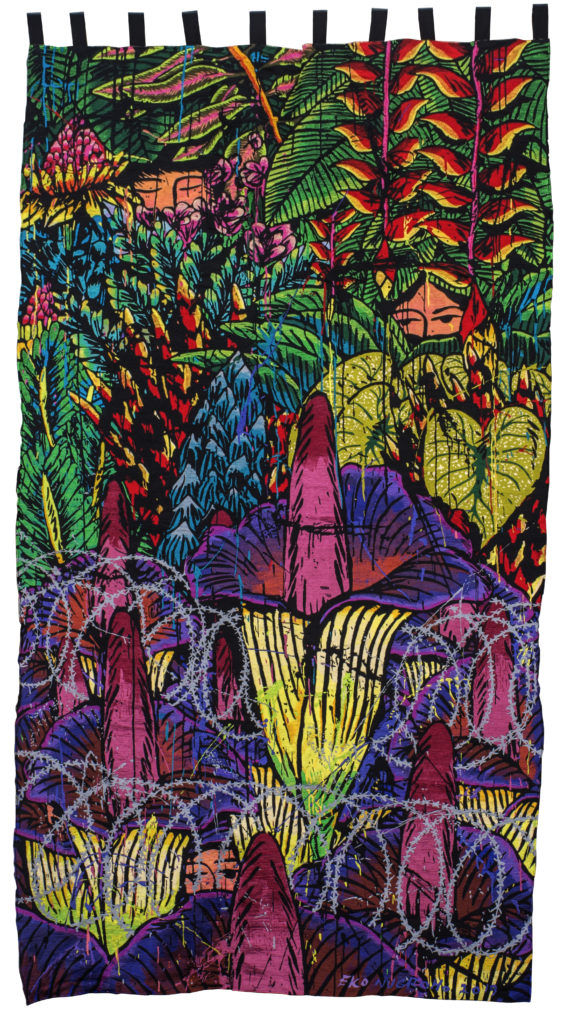This year, COVID-19 changes every person’s life, habits, daily activity, and also perspective. Social distancing is one of the solutions to prevent the contagion of the virus while everyone must wear a mask and regularly wash their hands. These new habits certainly affect one’s perspective on the concept of life, including the concept of art.
Eko Nugroho (born in Yogyakarta, Indonesia, in 1977) is an internationally-renowned contemporary artist from Indonesia who feels the side effect of the pandemic. Most of his artworks are inspired by street art and communities that are influenced by social, environmental, political, and economic issues. His works encompass various media such as mural, painting, sculpture, video, drawing, and embroidery.
The pandemic hits Eko Nugroho’s perspective to manifest his work of art. His current life during COVID-19 has changed his communication with the community, artwork concepts, and resulted in the cancellation of exhibitions. We talked to Eko Nugroho to find out more about his inspiration and how the current pandemic has affected his creation.

ACA project: Would you be keen to explain your inspirations in creating an artwork?
Eko Nugroho: My inspiration comes from what exists and happens around me like issues, situation, information, and anything that surround my life. It’s not just about my personal life, but also about where I live, stay, and something that occurs during my generation. These are my inspiration. Then daily routine, news, people I meet, experiences that happen to me, all of them become the biggest inspirations in every process of making my artwork.
ACA project: How do you work with the community to create your works?
Eko Nugroho: It all started with compassion. At first, I was interested in being involved with a lot of people when I was drawing on the street or doing mural art or street art. So my interest involved and connected various people who were passing by while creating artwork ; they gave inspiration to me. Thus, I decided to build a concept based on my will to work in collaboration with others – individuals or communities.
Since 2002, I’ve worked with manual embroidery as a medium, then in 2006-2007 I built an embroidery studio as a sign of the compassion with the coincidence situation. At that time, the embroidery workers in my area at Jogja have been evicted because of digitalization. Many embroidery shops now use a computer embroidery machine, so they have been laid off and not reinstated. That’s why I had an idea to involve them with their skill, which is manual embroidery, and I started to work with someone named Rinto.
Rinto used to be a manual embroidery worker in an embroidery shop. His shop has closed because he was unable to compete with other shops using computer embroidery, so Rinto lost his job. In the end, Rinto decided to move to another city and change his occupation as a farmer. Before he returned to his hometown in Tasikmalaya, I offered him to create a project with me : to make the embroidery I drew using manual embroidery – a skill he already has. And that’s how the project developed until we met another person named Soleh. It was from these two persons that the embroidery studio got bigger and was joined by their family – their siblings, cousins, and nieces.
The manual embroidery community can continue to be active and work as part of their economic circulation as well as I continue to be creative by producing artwork. This project with the community is based on social and deep caring values. It came with a different project, a batik project. I worked together with artisan communities in Jogja who work and create to embody the work of the artists, with plastic wastes recycle community and they continue to develop with other communities. So the beginning of this concern is what gives different strengths to cooperate and collaborate with other communities in creating art. As an artist, this togetherness and close kinship bring me into a pleasant environment and also a community ecosystem that produces art and works together. I can share economic, experience, and ideas. Likewise, they can share their experiences, skills, technics, and so on. This is where cooperation and mutualism mutually provide together.

ACA project: What would you like to expect when the audience sees your artwork?
Eko Nugroho: I hope that the public delves further into my art, not just for the technics and skills, but also for the process. It’s related to what I said about working with the community. Outside of it, I paint personally and privately on canvas. Painting is indeed a very personal part, which I don’t practice with many people or community. But projects such as embroidery, sculpture, wayang, batik, and design, are the projects that work with the communities. I hope that the public can appreciate more about the work of art, the process and how it manifests, as well as the meaning and the message from the artists themselves, because each artist has a different message to share. A unique message delivers in their artworks. I also hope that the public can relax and be happy by enjoying my arts, even though many of my works criticise or make flicks on the social value, democracy, and other things. But I visually want to provide space where all of us can enjoy the fine art, visual art, and that’s a part of my occupation. I hope the audience can combine both of them and give a bigger space for fantasy to the artworks and also to myself.
ACA project: What are the main issues you would like to raise through your works?
Eko Nugroho: Like I’ve said before, I am part of the general public at large, and I also stay in the social environment, I live in Indonesia, a country that embraces dynamic in politics, economy, culture, and whatever I experience is a part of the dynamic I get. It becomes an inspiration and values that I want to redeliver. As I have said before that an artist has a unique characteristic, he represents what he experiences and what happens around him, what belongs to his life, and what is his scope. Likewise, I am an artist with what happens around me, my habits, and environment, also a personal character within my society. So there are a lot of things that I want to say about Indonesia as a very dynamic country with its democracy. I am interested in dynamics when I observe and give critic values about what happened in my life and in my society, or I focus on the democracy in Indonesia as a point to criticise myself. What happens to me, to my home country, to the democracy that I experience, and that happens to things globally? It is also an integral part of me because I am a very open and modern person who can access all the information, not just about Indonesia. I also became interested in searching any fascinating thing in the world, anything interesting to criticise and put into the artwork.
ACA project: One of your recent artwork called « Museum of New Norm » was published in ArtJog: Resilience. Would you like to tell us the idea about this artwork?
Eko Nugroho: This artwork tells about the phenomenon which is happening globally in the world. When the COVID-19 pandemic hit worldwide, this outbreak marked a vital incident of world history. It changes the face of the generation and also has an immense presence on the world itself. The effects of this pandemic – so far until this interview goes on – are still very present broadly. We still have no idea about the future of this pandemic. The thing that excites me is how the outbreak changes history in various aspects such as social, technology, science, medical, health, and so on. There are some unique things that I’m interested in observing, such as how some individuals, personality, public, and humankind suddenly change rapidly, naturally and socially. Anti-social can be a dominant and principal behaviour to anticipate and fight the disease. Contradictory things and traits, or anything that is very contrary to human nature characteristic, which is us in an era or previous era, will drastically change after COVID-19.
How we’re doing the social distancing, not touching, not shaking hands, and not communicating directly, become our life purpose for a living. Also, self-isolating for our safety is a position and a trait that can change the pattern of human life. The work Museum of New Norm provides new experience about how humans change characteristically, personally, and have an impact on the community, on human society circles, even as people and humankind, and also as a state. Little things that change in human nature are very impactful on the extraordinary things in their lives. And it happens to every human being on this planet recently. From the work I have explored through the Museum of New Norm, I am very keen to gather these personalities into the museum form. I want to manifest their new human character forms after this pandemic through visual arts. This work will never stop on the work exhibited for Museum of New Norm, but it will keep developing with human characteristics consequently of the COVID-19 situation.
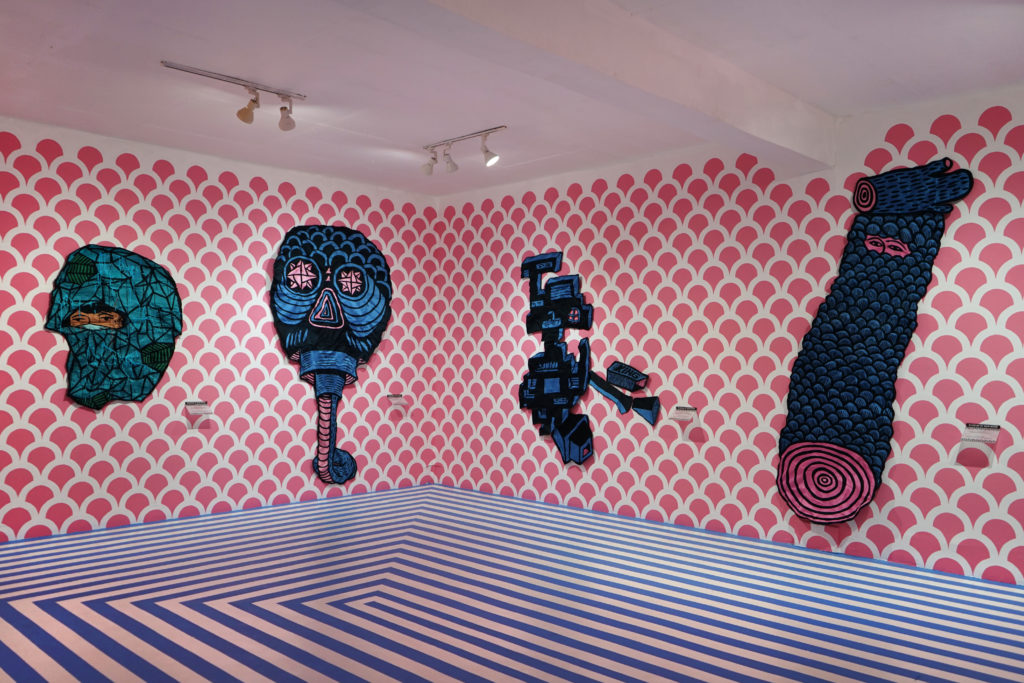
ACA project: COVID-19 really hits us hard. How do you think this event could change the way we experience art?
Eko Nugroho: I think it has an extensive impact. As for me, it is a small thing that will be extraordinarily impactful. Until now, I had never been unable to attend my solo exhibitions, which are prime events or activities for me. The presence of the artist at his/her solo exhibition is absolute and principal, as a form of accountability for the latest work and research on the displayed work. This how solo exhibitions create legitimation and validity to an artist who explores and then shows his/her latest artworks. In this 2020, I have experienced the inability to attend my solo exhibition at Arario Gallery in Seoul, South Korea, because of the COVID-19 situation.
Thus, my role had switched by using a digital approach through video. I’ve never been in such a situation before, and it gave me complicated and mingled feelings and situation. Ethically, this is opposite to what I imagined and described before. So this has changed my mindset and characteristic in the arts. Not to mention the artistic process, I isolated myself a lot, brought up some technics to be able to work together with a very limited technic with an extraordinary team of just a few specific people, not many. It also lead me to a point where I have to think about many strategies of work for further progress, because this pandemic will impact the event or work development activity in the future. According to me, there will be a lot of changes, we have to be more flexible and dynamic because I still want to work, create, and establish plenty of artworks. Whatever happens, I have to work this out. I’m lucky to have a team and a studio that can work together and establish some ways and strategies that we build and create ourselves during the pandemic. We will use these formulas we have invented to determine our steps forward to work art.
ACA project: Do you think online exhibitions might change someone’s perspective of art?
Eko Nugroho: Of course, it is not that easy, we need time. Visiting the artwork is not just a virtual visit, with no feelings; it is an experience. It is about how we attend an exhibition, enter the space, get the vibes, smell the ambiance of the artwork, the museum, the gallery, as well as the feeling of the sound vibes, the silence, and our emotions, then our closeness to the artwork; all of these are very complicated to deliver virtually. Today, we only can see through the flat screen. We see a sculpture as a painting, all flat. We see an installation artwork all flat as well. But those art experiences that can be enjoyed through smell, vibes, voice, interactive, etc. will change completely. They will be given a different and new perspectives and be very influential in the arts for sure. I’m pretty sure flexibility is one of the main characteristics for art. It means the art will always be art. It will be dynamic, which is a part of itself whatever occurs to it. Whether it is war, epidemic, whatever it is, art will have its own development: unique, formidable, suitable to its time.
ACA project: You recently created works for the exhibition « Plasticology » at The Goods Shed in Claremont, Australia. Could you tell us more about these works?
Eko Nugroho: This artwork is also interesting because I used a lot of plastics and scraps that I have assembled with the community and artisans, to establish into the visual art. Not just a sculpture, I created the work into two dimensions or relief like a painting, and I also designed masks. I kept exploring this work into projects I develop with the community. It is what I like because I don’t just work by myself. I also worked together with the plastic waste collectors, scavengers, plastic cleaners, and artisans who embody sculptures, even the long-lasting and safety methods and technics are part of the artwork. We keep exploring inventions and creations to make this work a reality which deserves to be enjoyed as a formidable and attractive artwork for the future and forever. This Plasticology work is also related to our previous project at Potatohead, Bali in 2017; a work that uses plastic waste too.
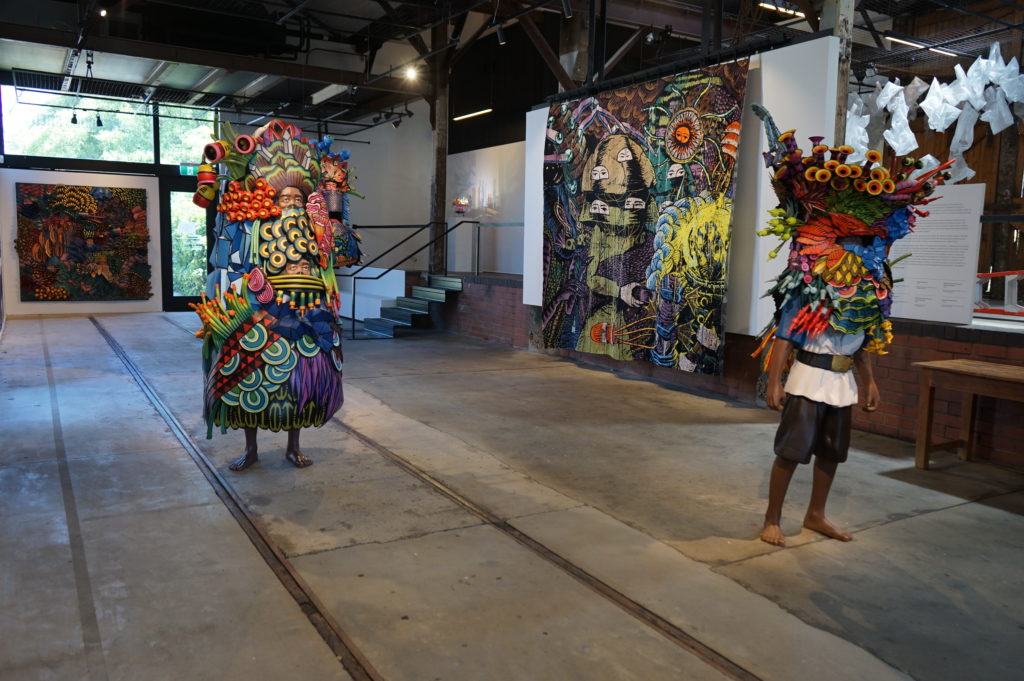
ACA project: How do you think art can raise awareness about the climate and environment crisis?
Eko Nugroho: Art can grow someone’s concern into many subjects, not just into climate change or environmental crisis, but also many other ones such as humanity, society, economy, etc. That means art can be very involved everywhere depending on the artist, in silence or not. If he truly wants to involve him/herself or not. I am very dynamic and open to try many things. So for me, being an artist is being flexible because the artist’s life becomes a part of the society. An artist becomes an art filter in the midst of a civilisation, with the form of character s/he carries artfully: it can be fine arts, music, film, etc. That means wherever artists exist, grow, and develop, art can become a part of that society. Art can be a part of a community which has its own concerns: it can be climate change, humanity, economic crisis, environmental crisis, and so on. It all depends on the artist and also the people acceptance, will they accept or also be open to it. While the artist wants to be open but the society is closed, there is a problem. But if we need to open together, the artist, the public, and the world of art, there will be a lot in matters of mutual concern, becoming universal issues.
ACA project: What are your future projects?
Eko Nugroho: They are many and always developing. I cannot explain in details but I will keep floating through the project I am currently developing. I will keep trying to improve myself, to be more professional, and to expand to more communities. How economy, creativity, education, spirit, and energy can be shared for some generation that desires to reveal something out there, in this tough time, and undetermined situation because of the pandemic COVID-19. I’m pretty sure that these spirits are still needed. I hold up those spirits to keep myself alive and create things. I will keep involving many people to share this energy so then everyone stays excited to do something positive and good. This, is the way we can survive to fight these difficult times.
Interview by Amirahvelda Priyono – October 2020
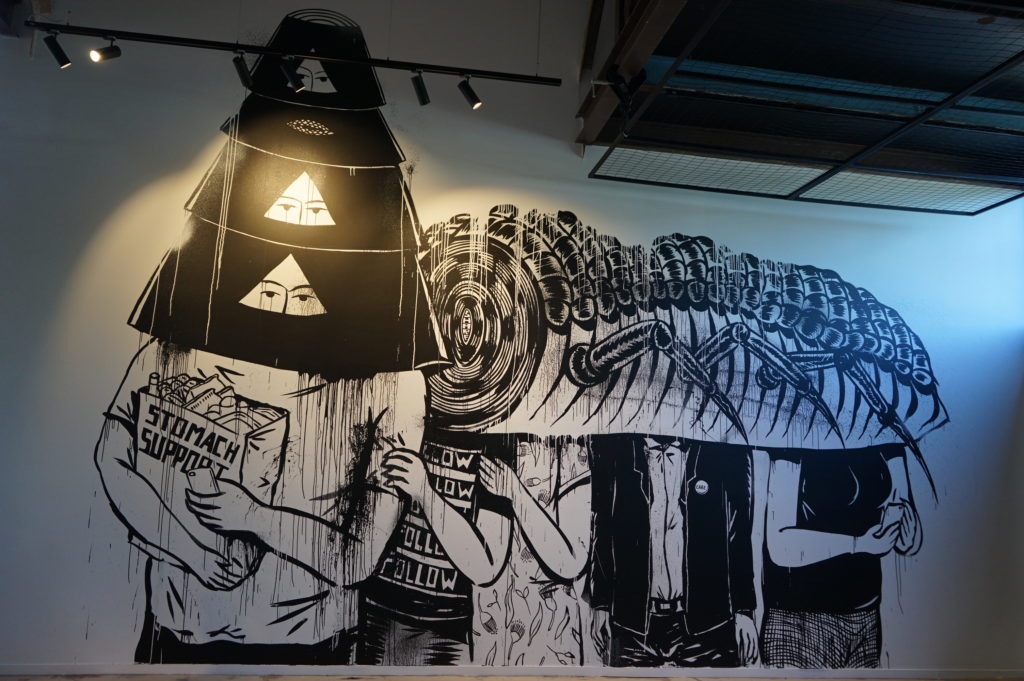
Cette année, la COVID-19 a changé la vie, les habitudes, le quotidien, et les perspectives de chacun. La distanciation sociale est une de solution pour prévenir du virus tandis qu’il faut porter un masque et se laver régulièrement les mains. Ces nouvelles habitudes nous affectent tous et nous invitent à poser un regard neuf sur ce nouveau concept de vie, notamment le concept d’art.
Eko Nugroho (né à Yogyakarta en Indonésie, en 1977) est un artiste indonésien de renommée internationale qui ressent les effets secondaires de la pandémie. La plupart de ses œuvres s’inspirent du street art et de la communauté, et sont influencées par les questions sociales, environnementales, politiques et économiques. Son oeuvre prend forme sous divers médiums tels que la peinture murale, la peinture, la sculpture, la vidéo, le dessin et la broderie.
La pandémie a frappé la perspective d’Eko Nugroho sur son art. Sa vie actuelle pendant la COVID-19 a changé sa communication avec la communauté, son concept artistique, et a contraint l’annulation de ses expositions. Nous avons interrogé Eko Nugroho pour en savoir plus sur ses inspirations et l’influence de la pandémie actuelle sur sa création.
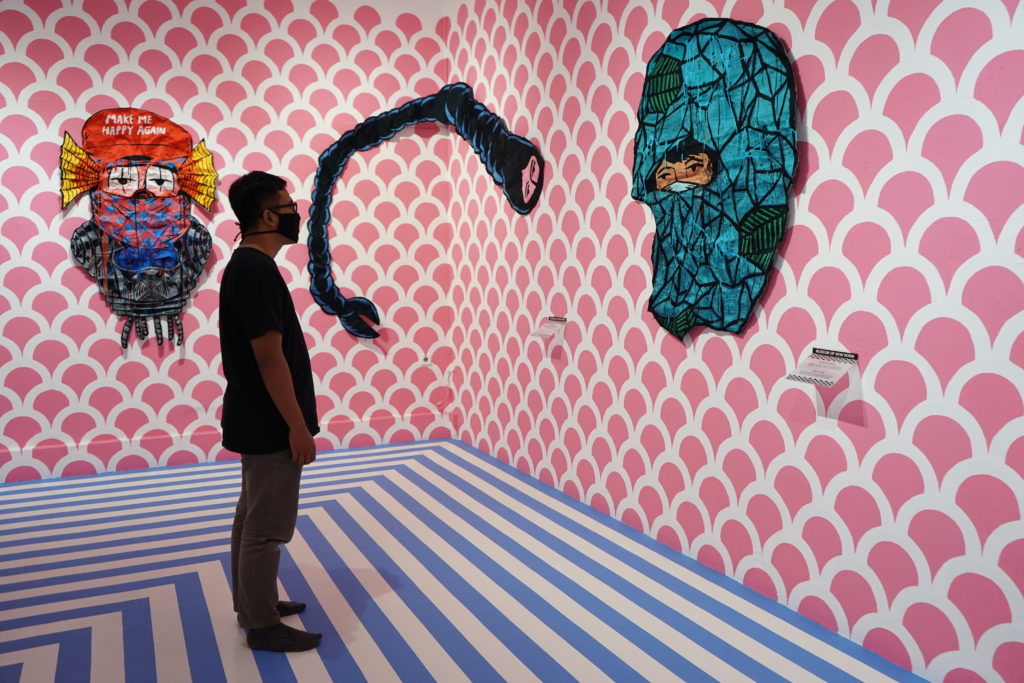
ACA project: Pourriez-vous nous parler de votre inspiration créatrice ?
Eko Nugroho: Mon inspiration vient de ce qui existe et se passe autour de moi – comme des problématiques, certaines situations et informations, et tout ce qui entoure ma vie. Il ne s’agit pas seulement de ma vie personnelle, mais aussi de l’endroit où je vis, où je demeure, et les endroits où des choses se produisent au cours de ma génération. C’est cela mon inspiration. Et également la routine quotidienne, l’actualité, les gens que je rencontre, les expériences qui m’arrivent, tout devient une grande inspiration dans chaque processus de réalisation de mon œuvre.
ACA project: Comment travaillez-vous avec la communauté pour réaliser vos oeuvres ?
Eko Nugroho: Tout a commencé par la compassion. Au début, j’étais intéressé de coopérer avec beaucoup de gens quand je dessinais dans la rue, faisais de l’art mural ou urbain. Ainsi, quand je créais des oeuvres, j’invitais les passants à participer et créais une connection avec eux, et ils m’inspiraient. C’est ainsi que j’ai décidé de créer un concept, celui de vouloir travailler en collaboration avec d’autres personnes, individuellement ou collectivement.
Depuis 2002 j’utilise la broderie manuelle comme médium dans mon travail, puis vers 2006-2007, j’ai monté un atelier de broderie par compassion face à la situation concomitante. A cette époque, les brodeurs de ma région à Jogja ont été expulsés suite au développement de la digitalisation. De nombreuses enseignes de broderie utilisent des machines à broder informatiques, ils ont donc été licenciés et non réintégrés. C’est pourquoi j’ai eu l’idée de les intégrer pour leur compétence en broderie manuelle, et j’ai commencé à travailler avec un dénommé Rinto.
Rinto travaillait comme brodeur manuel dans une enseigne de broderie qu’il a été contraint de fermer parce que son activité n’a pas pu rivaliser avec les enseignes concurrentes qui utilisent les machine à broder informatiques. Il a alors perdu son travail. Finalement, Rinto a décidé de s’installer dans une autre ville et a troqué sa profession pour celle de paysan. Avant qu’il retourne dans sa ville natale à Tasikmalaya, je lui ai proposé de créer un projet avec moi : de réaliser une broderie manuelle – grâce à sa compétence – à partir d’un de mes dessins. Et c’est ainsi que ce projet s’est développé jusqu’à la rencontre d’une autre personne appelée Soleh. C’est de ces deux personnes que l’atelier de broderie s’est agrandi et a été rejoint par leur famille ; leurs frères et sœurs, des cousins, des nièces, etc.
La communauté de broderie manuelle peut continuer à être active et à travailler pour faire circuler leur économie, et je continue à être créatif en réalisant des œuvres d’art. Ce projet avec la communauté est basé sur des valeurs sociales et d’affection profonde. Il s’est accompagné d’un autre projet, un projet batik. J’ai travaillé avec des communautés d’artisans à Jogja qui travaillent et créent pour incarner le travail des artistes, avec une communauté de recyclage des déchets plastiques, et qui continuent de se développer avec d’autres. Le point de départ de cet intérêt, est la source de forces différentes pour coopérer et collaborer avec d’autres communautés dans le but de créer des œuvres d’art. En tant qu’artiste, cette convivialité et cette affinité créent un environnement plaisant ainsi qu’un écosystème communautaire qui permet de produire de l’art ou de travailler en équipe. Je peux partager mon économie, mon expérience, mes idées. Par ailleurs, ils peuvent partager leurs expériences, leurs compétences, leurs techniques, etc. C’est là que la coopération et le mutualisme produisent ensemble et avec réciprocité.
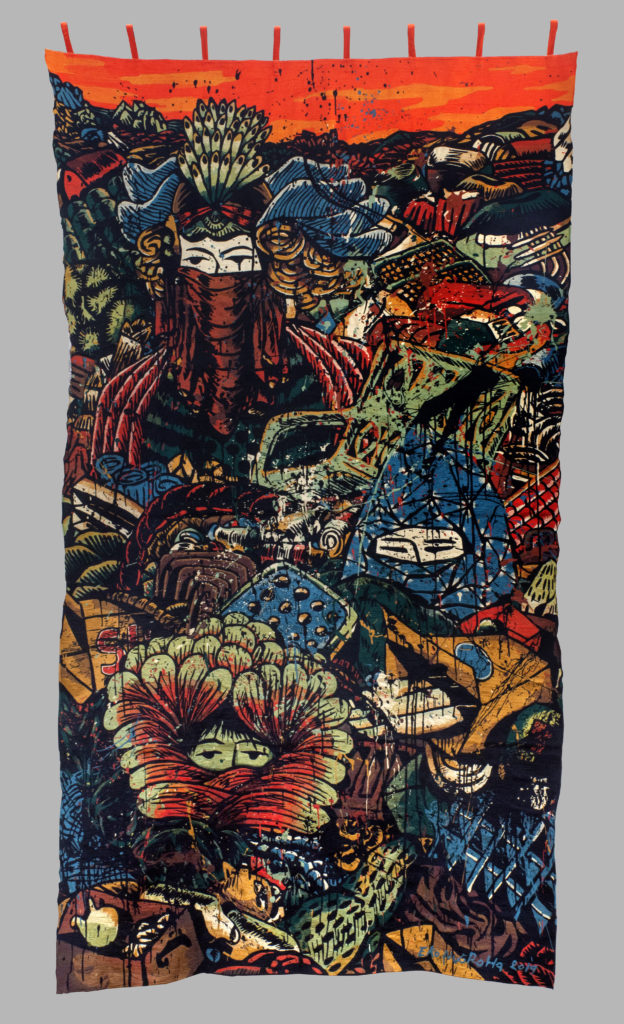
ACA project: Quelles réactions du public attendez-vous face à vos œuvres ?
Eko Nugroho: J’espère vraiment que le public se plonge dans mon œuvre avec profondeur, non seulement pour la technique et les compétences, mais aussi pour le processus. Cela rejoint ce que je disais précédemment sur le travail avec la communauté. En dehors de cela, je peins sur toile à titre personnel et privé. La peinture est en effet une activité très personnelle que je ne fais pas avec beaucoup de gens ni avec la communauté. Mais les projets de broderie, de sculpture, de wayang, de batik, et de dessin, sont tous des projets qui fonctionnent avec les communautés. J’espère que le public peut apprécier davantage mon oeuvre, son procédé et la façon dont il transparaît, ainsi que le sens et le message des artistes eux-mêmes car chaque artiste a un message différent. Un message unique dans leur œuvre. Et j’espère aussi que le public peut passer un agréable moment, trouver de la joie et apprécier mes œuvres même s’il beaucoup d’entre elles sont des critiques ou des offenses de la valeur sociale, de la démocratie, et d’autres sujets. Cependant, je souhaite visuellement créer un espace où nous pouvons tous profiter des beaux-arts, des arts visuels, et c’est une partie de mon métier, ce que je fais. J’espère que le public pourra combiner les deux et donner un plus grand espace à sa fantaisie aux œuvres d’art et aussi à moi-même.
ACA project: Quelles sont les principales problématiques que vous voudriez soulever avec vos œuvres ?
Eko Nugroho: Comme je l’ai dit auparavant, je fais à la fois partie du grand public, et je reste aussi dans l’environnement social et la vie en Indonésie, un pays qui embrasse le dynamisme de la politique, de l’économie, de la culture, et tout ce que j’expérimente fait partie de la dynamique que j’obtiens. Elle devient une inspiration et des valeurs que je veux redistribuer. Comme je l’ai déjà dit, un artiste possède une caractéristique unique, il représente ses expériences et ce qui se passe autour de lui, ce qui fait partie de sa vie, et ce qui est à sa portée. De même, je suis un artiste avec ce qui se passe autour de moi, mes habitudes, et mon environnement, aussi une personnalité au sein de ma société. J’ai donc beaucoup à dire au sujet de l’Indonésie qui sera un pays dynamique avec sa démocratie. La dynamique qui m’intéresse est celle qui provient de mon observation et de mes jugements de valeurs au sujet de ce qui m’est arrivé dans la vie et au sein de ma société, ou bien je pars d’un sujet principal qu’est la démocratie en Indonésie pour m’auto-analyser. Qu’arrive-t-il à moi-même, à mon pays natal, à la démocratie dont je fais l’expérience et qui a un impact à l’échelle mondiale ? C’est aussi une partie intégrante de moi-même car je suis une personne ouverte et moderne qui peut accéder à toutes les informations, pas seulement celles sur l’Indonésie. J’ai développé un intérêt pour la recherche de toute chose fascinante dans le monde, tout ce qui est intéressant à analyser ou à intégrer dans mon travail artistique.

ACA project: L’une de vos récentes œuvres appelée ‘Museum of the New Norm’ a été publiée dans « ArtJog : Resilience ». Pourriez-vous nous expliquer les idées derrière cette œuvre ?
Eko Nugroho: Cette oeuvre évoque un phénomène qui se passe à l’échelle mondiale. Lorsque la pandémie de COVID-19 a frappé à travers le monde, elle a marqué un incident vital dans l’histoire mondiale. Elle change le visage de la génération actuelle et a aussi un immense impact sur le monde lui-même. Les effets de cette pandémie – jusqu’au moment de cette entrevue – touchent toujours très largement la planète. Nous n’avons aucune idée de l’avenir de cette pandémie. Ce m’excite particulièrement, c’est comment la pandémie change l’histoire dans divers aspects tels que la société, la technologie, la science, la médecine, la santé, etc. Il y a des choses uniques que j’aime observer, par exemple comment certains individus, des personnalités, le public, l’humanité changent soudainement, rapidement, naturellement, et socialement. L’attitude antisociale peut être dominante et principale pour anticiper et combattre la maladie. Les éléments et traits contradictoires, et tout ce qui est contraire aux caractéristiques de la nature humaine, c’est-à-dire à nous-même aujourd’hui ou aux époques précédentes, changeront drastiquement après la COVID-19.
La mise en pratique de la distanciation sociale, ne pas se toucher, ne pas se serrer les mains, ne pas communiquer directement, tout cela devient un objectif de vie pour pouvoir vivre. Aussi, le fait de s’auto-isoler pour notre sécurité, cette attitude et ce trait peuvent changer le modèle de la vie humaine. L’œuvre Museum of the New Norm offre une nouvelle expérience sur la façon dont les humains changent leurs caractéristiques, leur personnalité, et ont un impact sur la communauté, les différents cercles qui constituent la société, que se soit en tant que personne et qu’humanité, et aussi comme état. Les petits éléments qui modifient la nature humaine ont une grande répercussion sur les événements extraordinaires de leur vie. Et ils sont récemment arrivés à chaque être humain sur cette planète. De ce travail que j’ai exploré pour Museum of New Now, je suis très désireux de recueillir ces personnalités sous forme de musée. Je voudrais montrer à travers les arts visuels les nouveaux caractères humains suite à cette pandémie. Ce travail ne s’arrêtera pas à ce qui a été exposé pour Museum of New Norm, mais il continuera à se développer en intégrant les caractéristiques humaines conséquentes à situation de la COVID-19.
ACA project: La pandémie de COVID-19 nous frappe de plein fouet. Comment pensez-vous que cet événement puisse changer nos façons d’expérimenter l’art ?
Eko Nugroho: Je pense qu’il a un impact considérable. C’est une petite chose qui a d’extraordinaires répercussions en ce qui me concerne. Jusqu’à présent, je n’avais jamais été empêché d’assister à mes expositions personnelles, qui sont des événements et des activités majeures pour moi. La présence de l’artiste à son exposition est nécessaire et capital, c’est comme une forme de responsabilité face aux travaux et aux recherches sur le travail artistique qui est présenté. C’est ainsi que les expositions personnelles créent la légitimité, la validité d’un artiste qui explore puis présente ses dernières créations. Cette année 2020, j’ai fait l’expérience d’être empêché d’être présent à mon exposition personnelle à la galerie Arario à Séoul (Corée du Sud) à cause des restrictions causées par la COVID-19.
Mon rôle a donc changé en utilisant une approche digitale à travers la vidéo. Je n’ai jamais été dans cette situation auparavant, et cela m’a provoqué des sentiments et une situation compliqués. Ethiquement, c’est le contraire de ce que j’avais imaginé et décrit. Cela a donc modifié mon état d’esprit et mes caractéristiques artistiques. Sans parler du processus artistique, je me suis beaucoup isolé, j’ai trouvé quelques solutions pour travailler ensemble avec une technique très limitée avec une équipe extraordinaire de quelques personnes spécifiques, et peu nombreuses. Cela m’a ainsi conduit à un point de réflexion sur des stratégies de travail à adopter pour continuer de progresser, car cette pandémie aura un impact sur l’événementiel ou le développement du travail à l’avenir. A mon avis, il y aura beaucoup de changements, nous devons être plus flexibles et dynamiques car je veux continuer de travailler, créer et produire de nombreuses œuvres d’art. Quoi qu’il arrive, je dois résoudre ce problème. J’ai la chance d’avoir une équipe et un studio qui peuvent travailler ensemble et instaurer des moyens et des stratégies que nous construisons et créons nous-mêmes pendant cette pandémie. Nous utiliserons ces formules que nous avons inventées pour déterminer les prochaines étapes de notre travail artistique.
ACA project: Pensez-vous que les expositions en ligne puissent changer nos perspectives sur l’art ?
Eko Nugroho: Bien sûr, et ce n’est pas facile, nous avons besoin de temps. La visite d’une œuvre d’art n’est pas seulement virtuelle, sans émotion ; c’est une expérience. Il s’agit de la façon dont on visite une exposition, dont on entre dans l’espace, dont on reçoit l’énergie, dont on ressent l’ambiance, de l’œuvre d’art, du musée, de la galerie, ainsi que les vibrations de son, de silence, et nos émotions, puis notre proximité à l’oeuvre, qui sont bien compliqués à rendre virtuellement. Aujourd’hui, nous ne voyons qu’à travers la platitude de l’écran. Nous percevons une sculpture comme une peinture, totalement plate. Nous voyons les installations artistiques à plat aussi. Mais ces expériences artistiques qui s’apprécient par l’odeur, la vibration, la voix, l’interactivité, etc., sont vouées à changer complètement. De nouvelles perspectives leur seront données, qui auront une influence considérable dans l’art de demain. Toutefois, je peux avancer avec certitude qu’une des caractéristiques de l’art est sa capacité à être flexible. Cela signifie que l’art sera toujours l’art. Il sera dynamique, c’est ce qui le constitue peu importe le reste : que ce soit la guerre, la pandémie, quoi que ce soit d’autre, l’art aura un développement qui lui est propre, unique, formidable, et adaptable à son époque.

ACA project: Vous avez créé récemment une œuvre pour l’exposition « Plasticology » à The Goods Shed à Claremont, Australie. Pourriez-vous nous parler de cette oeuvre ?
Eko Nugroho: Cette œuvre aussi est intéressante parce que j’ai utilisé beaucoup de plastique et de débris que j’ai assemblé avec la communauté et les artisans, pour créer une oeuvre d’art. Pas seulement une sculpture, j’ai également créé l’œuvre en deux dimensions et en relief comme une peinture, ainsi que des masques. J’ai continué à explorer cette œuvre dans les projets développés avec la communauté. C’est ce que j’apprécie ici, je ne travaille pas tout seul. Par ailleurs, j’ai aussi collaboré avec les collecteurs de déchets plastiques, les pilleurs de poubelle, les nettoyeurs de plastiques, les artisans qui travaillent la sculpture, même les méthodes et la technique sur la durabilité et la sécurité de la pièce font partie de l’œuvre d’art. Nous continuons d’explorer de nouvelles découverts et créations pour faire de cette œuvre une réalité qui mérite d’être appréciée comme une œuvre d’art formidable et intéressante pour l’avenir et pour toujours. Cette œuvre Plasticology est aussi en lien avec notre projet précédent à Potatohead, Bali au 2017 ; une œuvre qui utilise également le déchet plastique.
ACA project: Comment pensez-vous que l’art peut éveiller les consciences sur les questions climatiques et la crise environnementale ?
Eko Nugroho: L’art peut faire croître l’intérêt chacun pour plusieurs sujets, pas seulement pour le changement climatique ou la crise écologique mais bien d’autres, comme des questionnements sur l’humanité, la société, l’économie, etc. C’est-à-dire que l’art peut être très impliqué dans tous les domaines selon l’artiste, de manière directe ou pas. S’il veut vraiment s’impliquer ou pas. Je suis très dynamique et ouvert à m’essayer dans de nombreux domaines. Donc pour moi, être un artiste c’est être flexible car la vie d’un artiste devient une partie de la société. Un artiste devient un filtre artistique au sein d’une civilisation, avec des formes et caractéristiques qu’il porte habilement comme par exemple l’art visuel, la musique, le film, etc. Cela veut dire que partout où les artistes existent, grandissent, et se développent, l’art peut prendre part à cette société. Il peut être une partie de la communauté qui a ses propres préoccupations : le changement climatique, l’humanité, la crise économique, la crise écologique, etc. Tout dépend de l’artiste et de la réception par la société, l’acceptera-t-elle ou sera-t-elle ouverte. Quand l’artiste veut être ouvert mais que la société reste fermée, cela devient un problème. Si nous devons s’ouvrir ensemble, l’artiste, la société, et le monde de l’art, il y aura beaucoup de sujets d’intérêt mutuel, qui deviendront des problématiques universelles.
ACA project: Quels sont vos projets futurs ?
Eko Nugroho: Ils sont nombreux, et toujours en développement. Je ne peux pas entrer dans le détail mais je vais continuer de naviguer sur le projet que je développe actuellement. Je vais continuer d’essayer de m’améliorer, d’être plus professionnel, et de m’étendre à plus de communautés. Comment l’économie, la créativité, l’éducation, l’esprit, et l’énergie peuvent être partagés par une génération qui désire révéler ce qui se passe ici, en cette période difficile, dans cette situation incertaine causée par la pandémie de COVID-19. Je suis bien certain que ces esprits sont toujours nécessaires. Je m’accroche à ces esprits pour rester éveillé et continuer de créer. Je continuerai d’impliquer beaucoup de personnes pour partage cette énergie afin que tout le monde reste motivé de produire quelque chose de positif et de bon. C’est ainsi que l’on peut survivre pour lutter contre ces temps difficiles.
Propos recueillis par Amirahvelda Priyono – Octobre 2020
